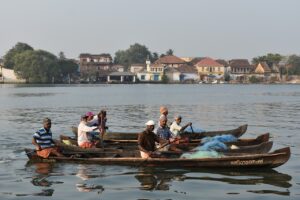
Kerala, renowned for its 590 km of scenic coastline, is grappling with escalating coastal erosion driven by climate change-induced sea-level rise, intensified cyclonic activity, and human interventions. Traditional mitigation methods like seawalls and groynes have often proven inadequate or even counterproductive. In response, Kerala is pioneering the integration of Artificial Intelligence (AI) with remote sensing and geospatial technologies to monitor, predict, and manage shoreline changes effectively.
Leveraging AI for Shoreline Monitoring
The adoption of AI in coastal management marks a significant shift from conventional practices. By analyzing satellite imagery and historical data, AI algorithms can detect patterns of erosion and accretion, enabling precise forecasting of shoreline dynamics. For instance, studies utilizing AI have successfully analyzed vulnerable coastal regions in Thiruvananthapuram district, identifying areas like Menamkulam, Puthenthope, and Veli as erosion hotspots.
Furthermore, tools like the Open Data Cube (ODC) have been employed to process Landsat satellite data, facilitating the extraction of shoreline information over time. This approach allows for efficient monitoring of coastal changes, providing valuable insights for policy-making and resource allocation.
Integrating Remote Sensing and GIS
The synergy between AI, remote sensing, and Geographic Information Systems (GIS) enhances the accuracy and efficiency of coastal monitoring. By employing the Modified Normalized Difference Water Index (MNDWI), researchers can effectively distinguish between land and water pixels in satellite images, enabling precise shoreline mapping. This integration supports the development of predictive models that inform proactive coastal management strategies.
Innovative Engineering Solutions: Geotubes and Beyond
In addition to technological advancements, Kerala is exploring innovative engineering solutions to combat coastal erosion. The implementation of geotube technology in areas like Poonthura involves installing large, sand-filled fabric tubes offshore to dissipate wave energy and encourage sand deposition. This method offers a sustainable alternative to traditional hard structures, minimizing environmental impact while enhancing coastal resilience.
However, challenges such as material shortages and rough sea conditions have delayed projects like the Poonthura offshore geotube breakwater, highlighting the need for robust supply chains and adaptive project management.
Data-Driven Decision Making
The integration of AI and geospatial technologies facilitates data-driven decision-making in coastal management. By continuously monitoring shoreline changes and predicting future scenarios, authorities can prioritize interventions, allocate resources effectively, and engage communities in resilience-building efforts. This proactive approach ensures that mitigation strategies are both scientifically informed and socially inclusive.
Embracing Nature-Based Solutions
While technological innovations are crucial, Kerala also recognizes the importance of nature-based solutions in coastal protection. Restoring coastal vegetation, such as mangroves, and implementing dune stabilization techniques contribute to natural defense mechanisms against erosion. These methods, when combined with AI-driven monitoring, offer a holistic approach to sustainable coastal management.
Future Outlook: Scaling Innovations
Kerala’s pioneering efforts in integrating AI with coastal erosion management serve as a model for other coastal regions facing similar challenges. Scaling these innovations requires continued investment in research, capacity building, and cross-sector collaboration. By fostering partnerships between government agencies, academic institutions, and local communities, Kerala can enhance its adaptive capacity and ensure the long-term sustainability of its coastal zones.
Conclusion: A Blueprint for Resilient Coasts
Kerala’s innovative approach to coastal erosion management, characterized by the integration of AI, remote sensing, and sustainable engineering solutions, exemplifies a forward-thinking strategy to address the complexities of climate change. By embracing technology and nature-based interventions, the state is not only safeguarding its coastline but also setting a precedent for resilient coastal governance worldwide.

Leave a Reply